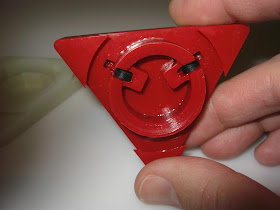I think I solved another mystery or two.
Jason Harris at SolidVision told me when I was setting up my SD300 that it might give a false 'replace cutting knife' error around layer 4 or 5 if the build material wasn't stacked tightly at the edge of the build table. It happened to me once in June 2010 the first time I used my SD300 after a long vacation.
A British SD300 user once told me that he tended to build several batches of models near the end of each month. His first build job would usually be sticky and the support material would be hard to remove, but all subsequent jobs would be normal. He worked around the problem by always building the built-in Test Model if he hadn't used the machine that month.
Today I built my first model since 17 December 2011, so my SD300 has been sitting idle for two weeks. I noticed something strange immediately. Normally the SD300 starts by bonding a layer of PVC onto the build table with an even layer of SolGL adhesive, but this time the adhesive was spotty. The adhesive appears here as dark spots underneath the red plastic--it should have been spread under the whole sheet, not just little spots as here.
Then I noticed a shiny droplet of SolGL glue near the edge of the table, on top of the PVC sheet. I'll bet it dripped there when the SD300 measured the material height with its micrometer, which is attached to the same unit that spreads the glue.
Ordinarily the machine's next step would spread anti-glue (masking fluid) onto this surface with a device like a felt-tip pen, but the droplet of SolGL glue would obviously contaminate the pen so I paused the SD300 and wiped up the glue with a paper towel.
Then I let the SD300 continue building to see what would happen. The next layer had fewer bubbles than the first, and the following layer didn't have any bubbles at all. I'm guessing air had seeped into the glue delivery system while the SD300 sat idle, but the air had all been cleared out now.
I wondered if I should cancel the job and start over now that the problem had apparently cleared itself up, but out of curiosity I let it keep running. Lucky thing, since what happened next was a revelation.
Starting at layer 4 in every job the SD300 automatically verifies the condition of the cutting knife by cutting a test pattern at the edge of the table. When this build reached layer 4 I heard a loud noise from the media feeder clutch which usually signals a cutting-knife failure. I watched closely as the SD300 automatically repeated the knife test a second time: the knife was good but the material was too loose. The machine raised the table and repeated the test again: the test succeeded this time, but the leverage from the knife dislodged the material so the PVC sheets loosened from the table.
The SD300 started building layer 5 by ironing a new sheet to the top of the model. Ordinarily it measures the stack with its micrometer to confirm the thickness of the last layer, but this time it started taking repeated measurements over and over. The red light came on and the SD300 displayed "HEIGHT CHECK ERROR" on the panel.
In my experience, the SD300 tries not to abandon a build if it can possibly continue so I tried pressing the material back onto the table and pressed the continue button. The SD300 obediently measured the model several times more, apparently trying to get a usable measurement, but stopped again with the same error.
The logs demonstrated the SD300 had made a good-faith effort to continue, but with the material flopping loose from the table it couldn't get a measurement within 446 microns. This was an error of over 100% because the last layer had only been 188 microns, so there was no sensible way the machine could have compensated.
So the only solution was to cancel the job and start again. Then it worked just fine, which makes sense in hindsight:
- The air bubbles in the glue lines had formed while the machine was idle. The bubbles would have cleared themselves within a few layers, but I could have cleared them manually by using the Clean Bubbles function in the SDMove maintenance utility.
- The droplet of SolGL glue was also caused by the air in the glue lines. It could have contaminated the anti-glue pens, but the contamination would have eventually resolved itself.
- A height check error within the first few layers of a job probably indicates there were bubbles in the glue lines, but the problem has already resolved itself by the time it's been detected.
All these issues are self-rectifying within a few layers, so I accept my British friend's solution as the simplest: just run a Test Model build job whenever the SD300 has been sitting idle. A test model uses very little material and it gives the machine an opportunity to work these issues out of its system without needing to understand them. Or I could just ignore these potential issues, since the worst that seems to occur is that I might have to re-run a job that fails within the first few layers.



































